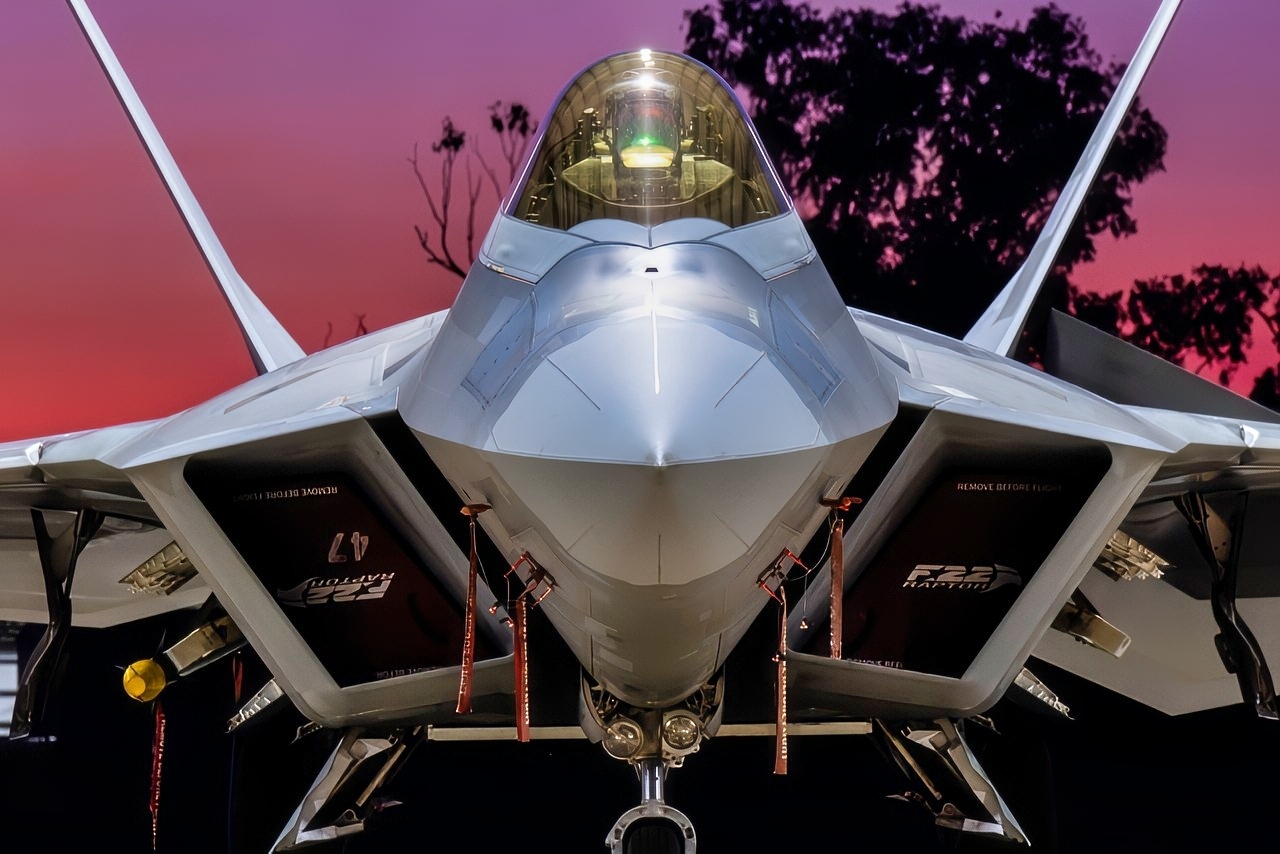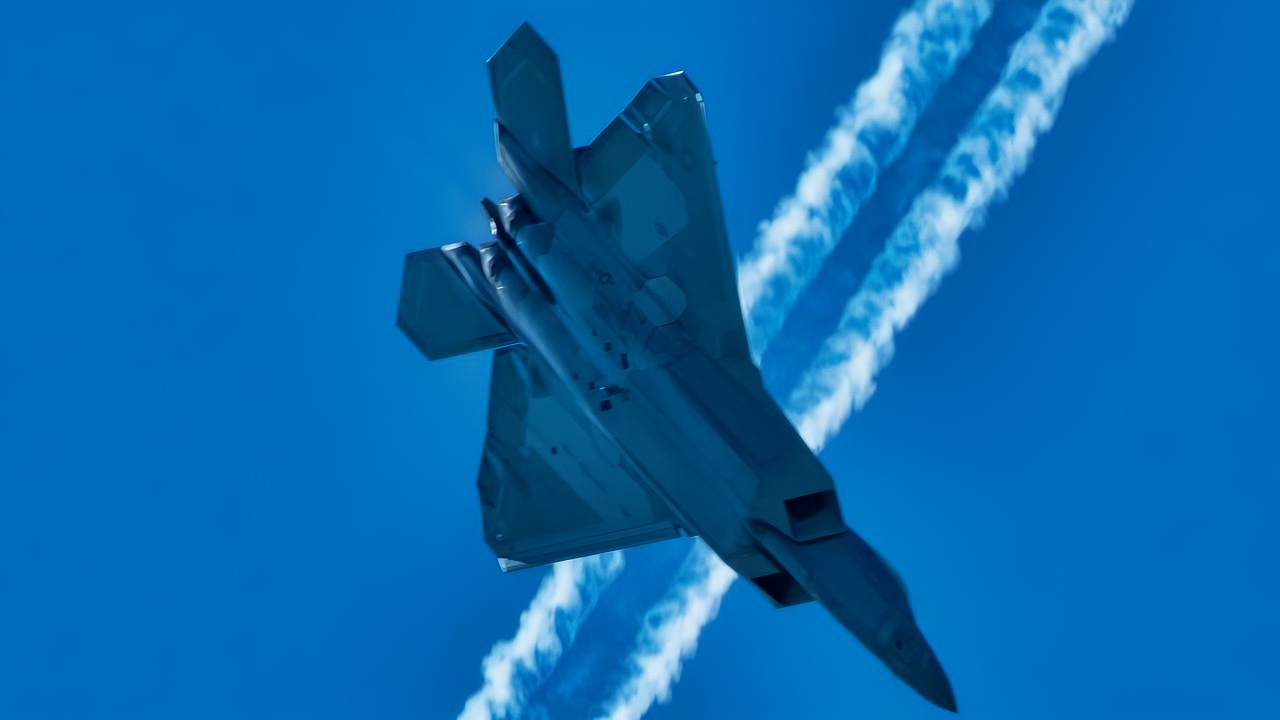Key Points: The F-22 Raptor has crossed a critical threshold, directly controlling an MQ-20 Avenger drone from its cockpit in a recent General Atomics demonstration.
-That loyal wingman setup cuts out ground control nodes, slashing latency and pushing decision-making to the tactical edge.

JOINT BASE PEARL HARBOR-HICKAM, Hawaii (July 17, 2018) – A 154th Wing Hawaii Air National Guard F-22 Raptor flies behind a 434th Air Refueling Wing KC-135 Stratotanker from Grissom Air Reserve Base, Indiana, near Hawaii during the Rim of the Pacific (RIMPAC) exercise July 17. Twenty-five nations, 46 ships, five submarines, and about 200 aircraft and 25,000 personnel are participating in RIMPAC from June 27 to Aug. 2 in and around the Hawaiian Islands and Southern California. The world’s largest international maritime exercise, RIMPAC provides a unique training opportunity while fostering and sustaining cooperative relationships among participants critical to ensuring the safety of sea lanes and security of the world’s oceans. RIMPAC 2018 is the 26th exercise in the series that began in 1971. (U.S. Air Force photo by Tech. Sgt. Samantha Mathison/Released)
-It caps a decade of manned–unmanned teaming work that began as a concept and matured through F-22/F-35 tests with Valkyrie CCAs at Emerald Flag.
-Now, Raptors and, eventually, F-35s will be able to task drones to probe air defenses, jam, surveil, and even fire weapons on command—turning fifth-gen fighters into airborne quarterbacks for entire unmanned strike packages.
F-22 Raptor Just Took Direct Control of a Combat Drone. Now What?
The famous and ever-improving F-22 Raptor recently completed a breakthrough demonstration of its ability to operate an MQ-20 Avenger drone from the aircraft’s cockpit, bringing a long-standing US Air Force tactical and strategic ambition closer to operational reality.
During a demonstration earlier this year conducted by MQ-20 drone-maker General Atomics, an F-22 directed the entire mission for the

A U.S. Air Force F-22 Raptor assigned to the 199th Air Expeditionary Squadron sits beneath a hangar as the sun sets in Northern Territory, Australia, July 16, 2025, during Talisman Sabre 2025. Talisman Sabre is the largest bilateral military exercise between Australia and the United States advancing a free and open Indo-Pacific by strengthening relationships and interoperability among key allies and partners, while enhancing our collective capabilities to respond to a wide array of potential security concerns. (U.S. Air Force photo by Senior Airman Natalie Doan)
Avenger drone, a capability that streamlines command and control, reduces latency, and refines new Concepts of Operation involving air-to-air manned-unmanned teaming.
It appears this development will set the precedent for the first-ever fighter-jet—Collaborative Combat Aircraft operations, which will likely include the extensively upgraded F-22.
Loyal Wingman
More than 10 years ago, former Air Force Chief Scientist Gregory Zacharias led a service effort to envision this tactical possibility: unmanned systems fully operated from the cockpits of fighter jets in the air.
This requires manned-unmanned teaming, hardened networking, advanced interfaces, streamlined command and control, and interoperable IP protocol or standards to enable secure passage of information between air platforms.
From this point forward, the concept became known as the “loyal wingman” dynamic, in which a drone operates under the direction of the fighter jet it supports.
The conceptual intent at the time, now an operational reality, was to massively improve latency by eliminating the need for drone-acquired data to pass through a ground-based command and control center before it could be used operationally.
Manned-unmanned teaming, in this respect, brings high-speed, time-sensitive decision-making closer to the tactical edge, massively improving and expediting what is known as the “kill chain” or “kill web.”
For instance, one or more drones could test enemy air defenses, jam communications, conduct wide-area targeting and surveillance, and even launch attacks when directed by a human.

U.S. Air Force Maj. Josh Gunderson, F-22 Demonstration Team pilot, soars through the sky during a demonstration practice Feb. 27, 2020, at Davis-Monthan Air Force Base, Ariz. The Heritage Flight Training Course is a training course for all single-ship aerial demonstration teams prior to the upcoming summer air show season. (U.S. Air Force Photo by Captain Kip Sumner)
Years of Progress
There have been many “steps along the way” over the past decade as fighter-jet-drone connectivity evolved from a conceptual vision into an operational reality.
Building upon the Concepts of Operation envisioned by Zacharias and other Air Force weapons developers in 2014, the Air Force Research Laboratory conducted a successful experiment in which an F-35 and an F-22 shared data in flight with the Valkyrie drone.
This flight, which took place during the Air Force’s 2024 Emerald Flag exercise, likely provided the technological foundation for the recent success connecting F-22s with CCAs.
During the exercise in 2024, the Valkyrie demonstrated its ability to act as a forward-deployed sensor platform, providing critical targeting data to Marine Corps F-35Bs and other aircraft through a secure data link known as Link-16.
Manned-Unmanned Teaming
Manned-unmanned teaming, as it is called, could be considered fundamental to the wave of the future in air warfare, as it naturally introduces new tactical possibilities for an attack.
Much of the prevailing consensus about what is likely to determine outcomes in future wars, especially if they involve great-power conflict, can be described in terms of “sensor-to-shooter” timelines. Air-to-air rapid connectivity between drones and armed, supersonic stealth fighter jets could enable attack aircraft to seek and destroy enemy targets before they are seen.
Interestingly, the Army was at the forefront of manned-unmanned teaming years ago, when Apache attack helicopter crews were engineered to view live feeds from nearby drones in the cockpit and to control a drone’s sensor payload and flight path.

U.S. Air Force Maj. Paul “Loco” Lopez, Air Combat Command F-22 Raptor Demonstation Team commander, flies the F-22 Raptor, demonstrating its combat capabilities at FIDAE (Feria Internacional del Aire y del Espacio) in Santiago, Chile, April 7, 2018. The Raptor is a multirole fighter capable of supporting both air-to-air and air-to-ground missions worldwide.
This technology, which was deployed to great effect in Afghanistan in recent years, reshaped helicopter attack tactics as Apache pilots were able to find, detect, and track enemy targets before even taking off, due to being able to receive incoming drone video feeds.
The technical advance is quite significant, as it not only reduces latency in terms of data transmission but naturally massively streamlines command and control such that fifth-generation fighter aircraft such as the F-22 and F-35 jets can control the flight path, mission scope, and sensor payload of nearby drones to test enemy defenses, blanket areas with forward-surveillance or even fire weapons when directed by humans.
Perhaps F-35 jets could operate a small forward fleet of mini-drones to jam enemy radar, overwhelm sensors, or network targeting data back to air and ground nodes.
About the Author: Kris Osborn
Kris Osborn is the President of Warrior Maven – Center for Military Modernization. Osborn previously served at the Pentagon as a highly qualified expert in the Office of the Assistant Secretary of the Army—Acquisition, Logistics & Technology. Osborn has also worked as an anchor and on-air military specialist at national TV networks. He has appeared as a guest military expert on Fox News, MSNBC, The Military Channel, and The History Channel. He also has a Masters Degree in Comparative Literature from Columbia University.










